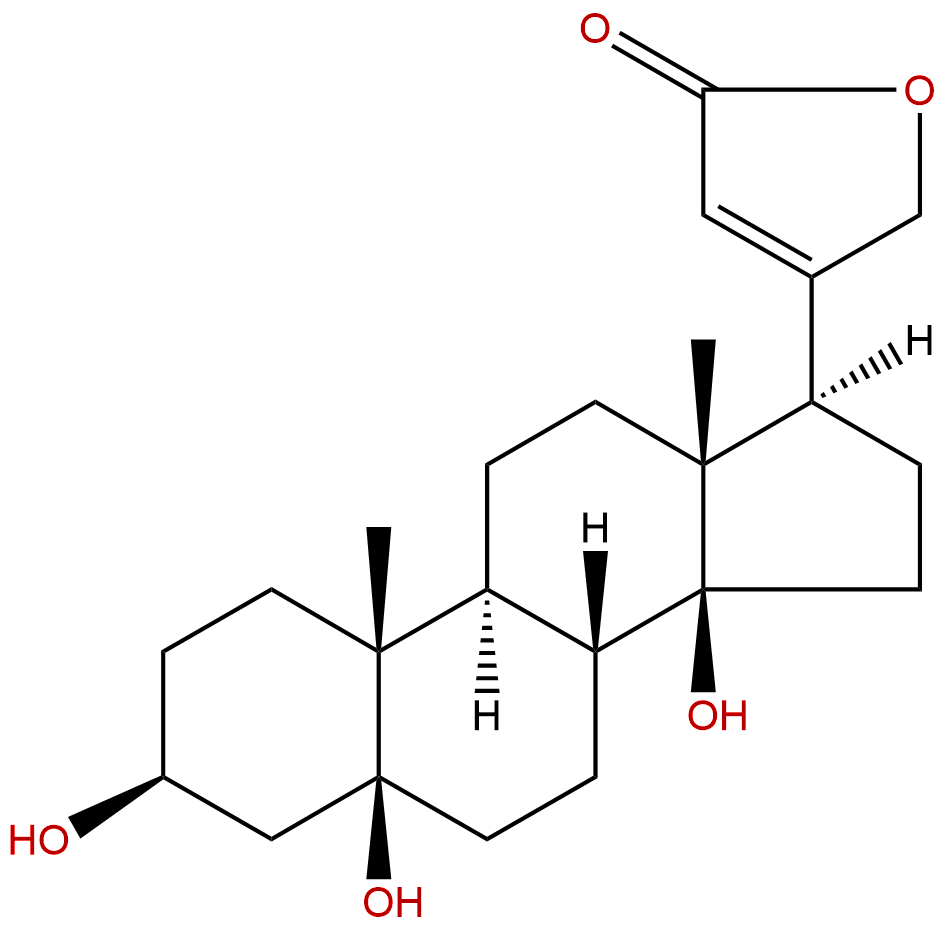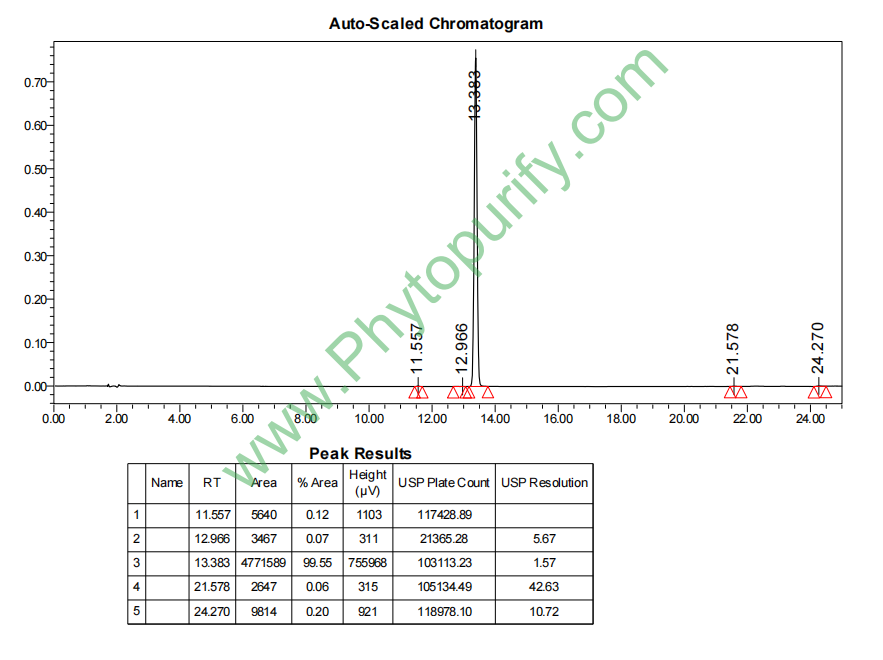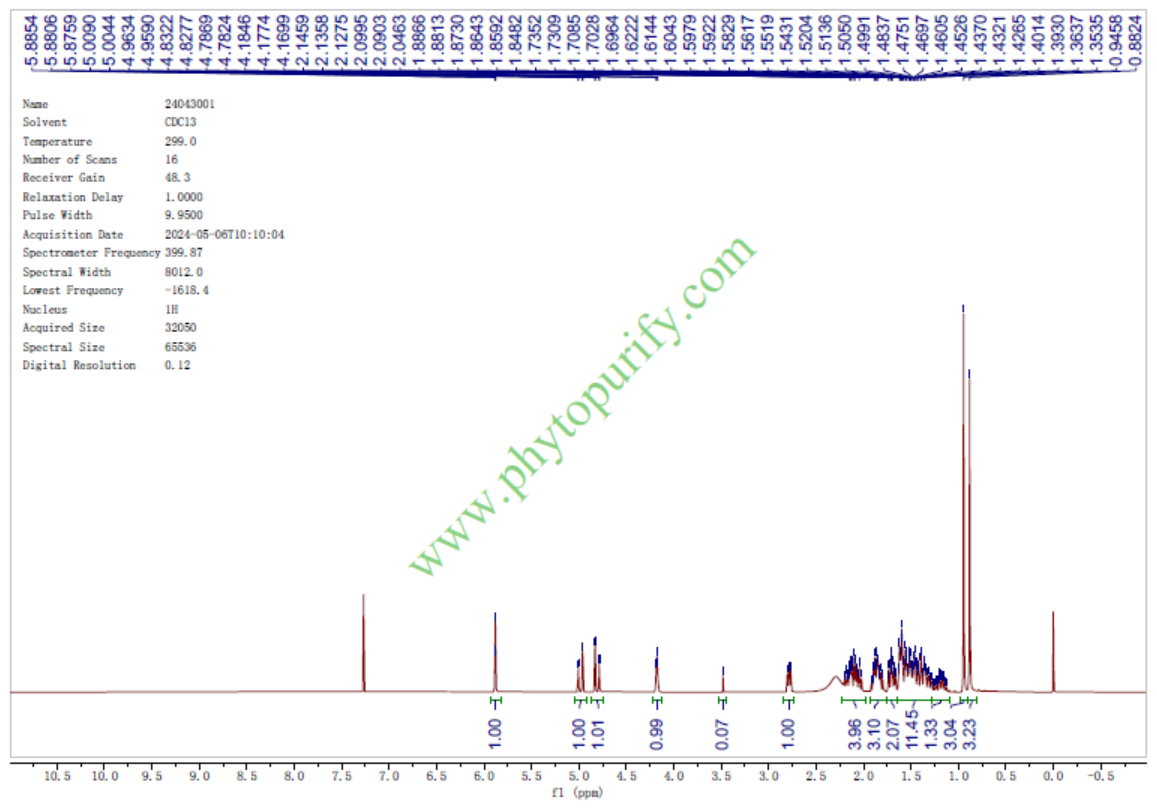
PeriplogeninCAS No.:514-39-6
|
||||||||||
 |
|
|
||||||||

| Catalogue No.: | BP1613 |
| Formula: | C23H34O5 |
| Mol Weight: | 390.52 |
Product name: Periplogenin
Synonym name:
Catalogue No.: BP1613
Cas No.: 514-39-6
Formula: C23H34O5
Mol Weight: 390.52
Botanical Source: " Isol. from seeds of Strophanthus preussii, from Castilla elastica, Pentopetia androsaernifolia, Antiaris africana, Antiaris toxicaria and others. Isol. from defence secretion of Chrysolina coerulans"
Physical Description: Powder
Type of Compound: Steroids
Purity: 95%~99%
Analysis Method: HPLC-DAD or/and HPLC-ELSD
Identification Method: Mass, NMR
Packing: Brown vial or HDPE plastic bottle
The product could be supplied from milligrams to grams. Inquire for bulk scale.
We provide solution to improve the water-solubility of compounds, thereby facilitating the variety of activity tests and clinic uses.
For Reference Standard and R&D, Not for Human Use Directly.
Description:
Periplogenin plays protective roles against thyrotoxicosis and associated cardiovascular problems, are mediated through its direct antithyroidal and/or LPO inhibiting properties. Periplogenin induces necroptotic cell death through oxidative stress in HaCaT cells and ameliorates skin lesions in the TPA- and IMQ-induced psoriasis-like mouse models.
References:
Biochem Pharmacol. 2016 Apr 1;105:66-79.
Periplogenin induces necroptotic cell death through oxidative stress in HaCaT cells and ameliorates skin lesions in the TPA- and IMQ-induced psoriasis-like mouse models.
Psoriasis is a multifactorial skin disease that inconveniences many patients. Considering the side effects and drug resistance of the current therapy, it is urgent to discover more effective and safer anti-psoriatic drugs.
METHODS AND RESULTS:
In the present study, we screened over 250 traditional Chinese medicine compounds for their ability to inhibit the cell viability of cultured human HaCaT keratinocytes, a psoriasis-relevant in vitro model, and found that Periplogenin was highly effective. Mechanistic studies revealed that apoptosis and autophagy were not induced by Periplogenin in HaCaT cells. However, Periplogenincaused PI to permeate into cells, increased lactate LDH release and rapidly increased the number of necrotic cells. Additionally, the typical characteristics of necrosis were observed in the Periplogenin-treated HaCaT cells. Notably, the necroptosis inhibitor Nec-1 and NSA were able to rescue the cells from necrotic cell death, supporting that necroptosis was involved in Periplogenin-induced cell death. Furthermore, the ROS levels were elevated in the Periplogenin-treated cells, NAC (an antioxidant) and Nec-1 could inhibit the ROS levels, and NAC could attenuate necroptotic cell death, indicating that the Periplogenin-induced necroptotic cell death was mediated by oxidative stress. More importantly, in the murine models of TPA-induced epidermal hyperplasia and IMQ-induced skin inflammation, topical administration of Periplogenin ameliorated skin lesions and inflammation.
CONCLUSIONS:
In sum, our results indicate, for the first time, that Periplogenin is a naturally occurring compound with potent anti-psoriatic effects in vitro and in vivo, making it a promising candidate for future drug research.
Horm Metab Res. 2011 Mar;43(3):188-93.
Periplogenin, isolated from Lagenaria siceraria, ameliorates L-T₄-induced hyperthyroidism and associated cardiovascular problems.
The importance of glycoside in the regulation of thyroid dysfunction is not well understood.
METHODS AND RESULTS:
In the present investigation, effects of Periplogenin-3- O-D-glucopyranosyl (1→6)(1→4)-D-cymaropyranoside, isolated from the vegetable, LAGENARIA SICERARIA, in L-thyroxine (L-T₄)-induced hyperthyroidism and in related cardiovascular abnormalities have been revealed in Wistar albino rats. L-T₄ (500 μg/kg, s. c./d) administration for 12 days significantly increased serum concentrations of thyroxine (T₄), triidothyronine (T₃), and hepatic 5'-deiodinase I (5'-DI) activity with a parallel increase in lipid peroxidation (LPO) in different organs such as heart, liver and kidney; serum glucose and insulin concentrations and a decrease in cardiac Na (+)-K (+)-ATPase activity as well as serum total cholesterol, high-density lipoprotein cholesterol, low-density lipoprotein cholesterol, very low-density lipoprotein cholesterol and triglycerides. Most of these adverse effects were reversed following the administration of isolated Periplogenin. However, out of its 3 different concentrations (5.0, 10, and 25 mg/kg), 5 mg/kg appeared to be the most effective one as it could nearly normalize the level of T₃, glucose, insulin, Na (+)-K (+)-ATPase activity, tissue LPO and different serum lipids suggesting the protective role of Periplogenin against thyrotoxicosis and associated cardiovascular problems.
CONCLUSIONS:
It appears that the Periplogenin actions are mediated through its direct antithyroidal and/or LPO inhibiting properties.
HPLC of Periplogenin

HNMR of Periplogenin
